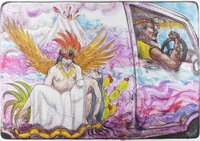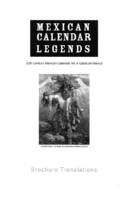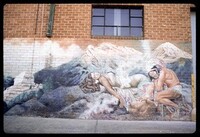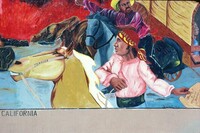Search Results
Subject is exactly
Legends
Use buttons below to view additional pages.
-

Cholo Van with Popo and Izta
title Cholo Van with Popo and Iztadescription Color lithograph on paper, 52.5 in. x 39 in. In his print, Jiménez portrayed the Aztec legend of Popo and Izta in a “moving mural” decorating a van driven by a Chicano cholo. The lovers Popocatépetl and Iztaccíhuatl are symbolized in the twin volcanoes of Mexico. His imagery shows the synthesis of Mexican and Chicano cultural expression, contextualized within American popular culture. This work also represents the artist’s lifelong fascination with automobiles, which are a critical part of the U.S. economy, industry, and society. Proud of his Chicano roots, Luis Jiménez (1940 – 2006) was an El Paso, Texas native, best known for his large-scale, brightly colored sculptures immersed in the Chicano iconography of Texas and New Mexico. Jiménez studied art and architecture at The University of Texas in Austin and El Paso. He eventually traveled to Mexico to study the famous Mexican muralists Diego Rivera and José Clemente Orozco, and was also influenced by regionalists Thomas Hart Benton and Grant Wood. After completing school, he went to work for his father making neon signs and car decals. In 1966 Jiménez moved to New York and joined the Pop Art scene, making painted fiberglass figurative works inspired by the everyday lives of Latinos living in the Southwest. His work shows his concern for working-class people and those who have suffered from discrimination. Jimenez was and remains respected in Latino communities for his perspective and narrative of the culture of Mexico and the Southwest. His artwork emulates popular Cholo car culture, demonstrated in his use of fiberglass, spray paint, and imagery consisting of Aztec emperors, border crossing, and vaqueros riding wild broncos. His works are in the collections of the Albuquerque Museum, the Smithsonian American Art Museum in Washington, D.C., the El Paso Museum of Art, the Metropolitan Museum of Art in New York, the Art Institute of Chicago, and the Museum of Fine Arts in Houston, among others.artist/creator Jiménez, Luissubject Borderlands Frontera Cholos Vans Aztecs Legends Love in art Marriage Color lithographs Lithographs Prints Life and Experiences in the U.S./Mexico Borderlands (exhibition)contributor Mexic-Arte Museum (MAM) -

Air, Earth, Fire, Water
title Air, Earth, Fire, Waterdescription Color lithograph on paper, 42 in. x 57.25 in. Well known Chicano artist Luis Jiménez interpreted the Aztec legend of the two lovers Iztaccíhuatl and Popocatépetl. The warrior Popocatépetl was sent to battle by his king, who wanted to discourage the romance between his daughter Princess Iztaccíhuatl and Popocatépetl. Although the king had promised Popo his daughter’s hand in marriage, he hoped that Popo would die in battle, so he lied to his daughter that her lover was dead. Izta died of a broken heart. When Popo returned to find her dead, he knelt down to hold her lifeless body. The gods took pity on the two lovers and covered them with snow. The story describes the origin of the volcanoes Popocatépetl (“the Smoking Mountain”) and Iztaccíhuatl (“White Woman” in Nahuatl, sometimes called the “Mujer Dormida’’ or “Sleeping Woman” in Spanish). Volcanoes are the home of the gods and considered sacred in Mexico. In the title of the print references the original elements in nature. These popular Aztec lovers decorate calendars, murals, T-shirts, and automobiles.artist/creator Jiménez, Luissubject Borderlands Frontera Aztecs Legends Volcanoes Love in art Elements Nature in art Color lithographs Lithographs Prints Life and Experiences in the U.S./Mexico Borderlands (exhibition)contributor Mexic-Arte Museum (MAM) -

Pamphlet: "Mexican Calendar Legends" Brochure Translations
title Pamphlet: "Mexican Calendar Legends" Brochure Translationsdescription Pamphlet that advertises an exhibition presented by the Mexic-Arte Museum entitled "Mexican Calendar Legends, 20th Century Mexican Calendar Art in Galas de Mexico". Along with the title of the exhibition and an image of a painting from the exhibition, the cover of the pamphlet also establishes that the pamphlet is made up of "Brochure Translations" from a separate gallery guide that is in Spanish. The first page features an introduction about the exhibition. The majority of remaining pages list the artists that are included in the exhibition as well as a short biography and description of the type of artwork each one produces. The last two pages list a few of the "classic themes of the calendar paintings". The back cover of the pamphlet features the sponsors of the museum and the exhibition as well as information about the exhibition and the museum.artist/creator Davis & Davis Translatorssubject Education - Events Artists Museum Exhibits -- Texas -- Austin. People - Ethnic Groups - Hispanics Legends Mexicans Translations Latinos Exhibits Arts And Craftscontributor Portal to Texas History (TPTH) -

Sleeping Woman, El Sereno, 1984
title Sleeping Woman, El Sereno, 1984description Sleeping woman, untitled mural, El Sereno, 1984. 5477 Alhambra Avenue, rear (at Warwick Avenue), El Sereno. An Aztec warrior kneel beside a sleeping woman, illustrating a popular legend. A Latino woman holds the Mexican flag. Acrylic on brick, 2 panels, 25' x 15', by Fernando Sandoval. -- Dunitz, Street gallery, p. 117, #15.contributor Calisphere -

Great Wall Of Los Angeles: Detail: 1880 Frontier California, Joaquin Murrieta
title Great Wall Of Los Angeles: Detail: 1880 Frontier California, Joaquin Murrietadescription A collaborative project by Judith Baca and over 400 employed youths and artists. The first one thousand feet were painted during the first summer of work in 1976. Additionally the first one thousand feet were divided into sections of 100 feet each. Although the content is highly integrated, each section was designed by a different artist under the general supervision of Judith Baca. Digital Library Development Program, UC San Diego, La Jolla, 92093-0175 (https://lib.ucsd.edu/digital-library) Los Angeles Valley College Narrative mural depicting California history from prehistory thru the 1920s. This detail focuses on Joaquin Murieta, Robin Hood figure of the old west who fought for the oppressed. Paintings Tujunga Wash, Los Angeles (California)artist/creator Baca, Judith Franciscasubject Horses Mexican American Art Mural Painting And Decoration History Legends Murieta, Joaquin, D. 1853 Narrative Art Symbolism California Pony Expresscontributor Calisphere